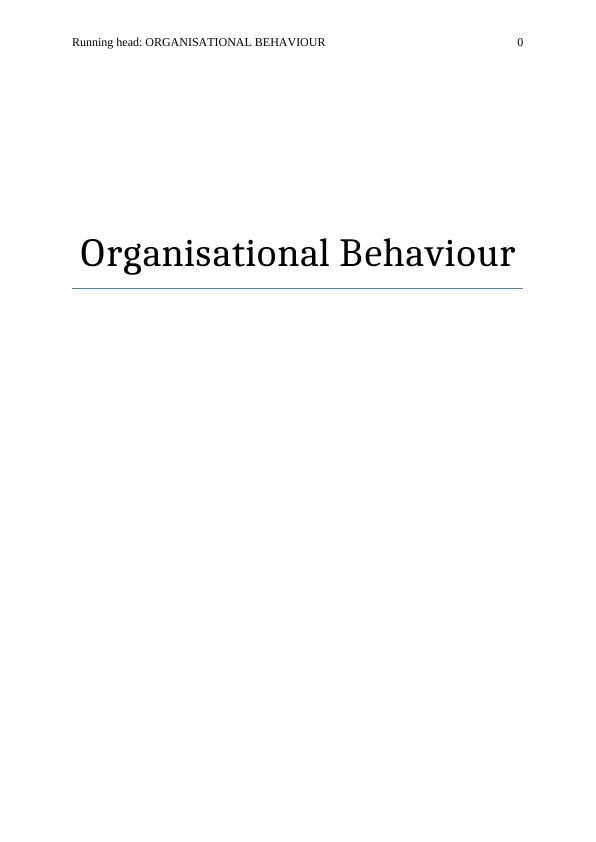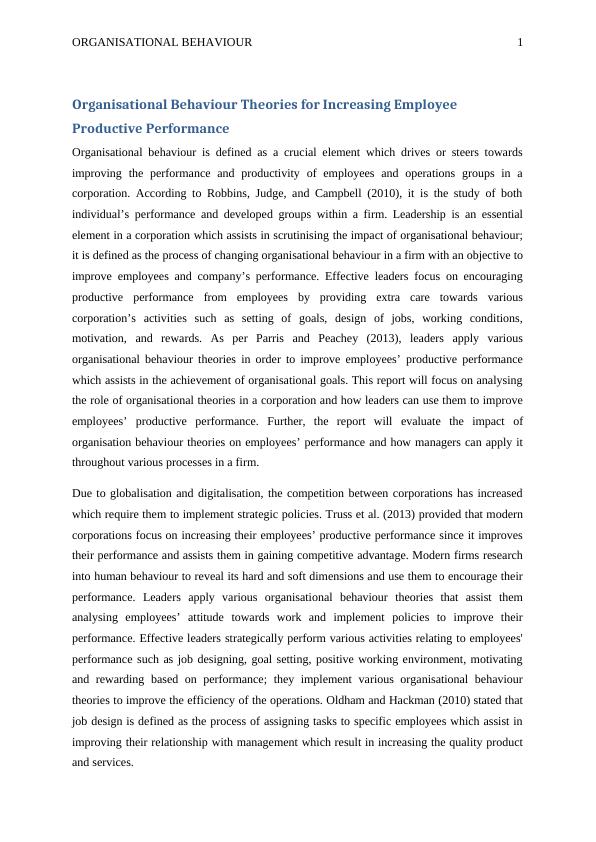Organisational Behaviour Theories for Increasing Employee Productive
8 Pages2473 Words46 Views
Added on 2020-05-28
Organisational Behaviour Theories for Increasing Employee Productive
Added on 2020-05-28
ShareRelated Documents
Running head: ORGANISATIONAL BEHAVIOUR0Organisational Behaviour

ORGANISATIONAL BEHAVIOUR1Organisational Behaviour Theories for Increasing Employee Productive PerformanceOrganisational behaviour is defined as a crucial element which drives or steers towardsimproving the performance and productivity of employees and operations groups in acorporation. According to Robbins, Judge, and Campbell (2010), it is the study of bothindividual’s performance and developed groups within a firm. Leadership is an essentialelement in a corporation which assists in scrutinising the impact of organisational behaviour;it is defined as the process of changing organisational behaviour in a firm with an objective toimprove employees and company’s performance. Effective leaders focus on encouragingproductive performance from employees by providing extra care towards variouscorporation’s activities such as setting of goals, design of jobs, working conditions,motivation, and rewards. As per Parris and Peachey (2013), leaders apply variousorganisational behaviour theories in order to improve employees’ productive performancewhich assists in the achievement of organisational goals. This report will focus on analysingthe role of organisational theories in a corporation and how leaders can use them to improveemployees’ productive performance. Further, the report will evaluate the impact oforganisation behaviour theories on employees’ performance and how managers can apply itthroughout various processes in a firm.Due to globalisation and digitalisation, the competition between corporations has increasedwhich require them to implement strategic policies. Truss et al. (2013) provided that moderncorporations focus on increasing their employees’ productive performance since it improvestheir performance and assists them in gaining competitive advantage. Modern firms researchinto human behaviour to reveal its hard and soft dimensions and use them to encourage theirperformance. Leaders apply various organisational behaviour theories that assist themanalysing employees’ attitude towards work and implement policies to improve theirperformance. Effective leaders strategically perform various activities relating to employees'performance such as job designing, goal setting, positive working environment, motivatingand rewarding based on performance; they implement various organisational behaviourtheories to improve the efficiency of the operations. Oldham and Hackman (2010) stated thatjob design is defined as the process of assigning tasks to specific employees which assist inimproving their relationship with management which result in increasing the quality productand services.

ORGANISATIONAL BEHAVIOUR2Many leaders use ‘Herzberg's Two Factor Theory’ while designing various organisationaljobs to ensure that employees are satisfied with their posts; it was provided by FrederickHerzberg. As per Yusoff, Kian, and Idris (2013), the theory provides that there are variousfactors in a corporation which causes job satisfaction or dissatisfaction, and they actindependently of each other. There are several motivators and demotivators in a job whichcause satisfaction and dissatisfaction in employees. The motivators include advancement,new responsibilities, achievement, growth, recognition, and others; the demotivators includepolicies, quality of leadership, pay, office relationships, working environment, status,security, and others. These factors influence an employee's performance, for example, acompany with outdated policies, low pay grade, and hostile environment will not be able tomotivate their employees by providing bonuses. Zeffane (2010) provided that the leadershave to strategically monitor the organisational environment to implement effective policieswhich increase employees' productivity along with company's performance.According to Yamuna and Devi (2016), Tesco PLC uses Herzberg’s theory to motivate itsemployees; as a result, the employees are highly motivated and empowered because ofeffective communication facilities. The company held forums every year which allow staffmembers to contribute their input on pay rises; Tesco personnel are also allowed to providetheir input during designing of restaurants menus or retail stores to avoid dissatisfaction.Similarly, ‘Job characteristics model (JCM) theory’ also focuses on five core job dimensionswhich include skill variety, task significance, autonomy, task identity and feedback to ensurethat employees are satisfied with their jobs. As per Piccolo et al. (2010), managers should usethis theory during the recruitment process to ensure that they select “right person for the rightjob”. Working condition of a corporation significantly influences its employees’ behaviour,and it increases or decreases their productivity. Leading organisation such as Apple, Google,Microsoft, and Facebook focus on establishing an effective working environment thatpromotes and support employees’ innovation approach which provides them a competitiveadvantage. Leaders can implement ‘culture theory’ which provides that corporations areformed based on cultural values that provide what is right or wrong. The ‘Personality-Job Fit theory’ given by John Holland provides that occupation environmentand personality types determine job satisfaction of workers. There are six basic personalitytypes which include realistic, artistic, social, investigative, conventional and enterprising(Whitteberry, 2016). Managers should use this theory during various organisational processessuch as job designing, departmentalisation, and delegation to ensure that employees’

End of preview
Want to access all the pages? Upload your documents or become a member.
Related Documents
Job recognition in the case study of Flora's Fast Food Contentslg...
|10
|2186
|336
EMPLOYEE PRODUCTIVE PERFORMANCE Through Organisational Behaviour Theorieslg...
|8
|2442
|328
Equity Theory in Human Resource Managementlg...
|7
|1893
|325
Importance of Motivation and Leadership in Organisational Behaviour - Deskliblg...
|9
|1646
|302
Organisation Behaviour Management: A Case Study of Woolworth Limitedlg...
|11
|687
|47
Concept and Drivers of Employee Engagement in Human Resource Managementlg...
|10
|2510
|24
